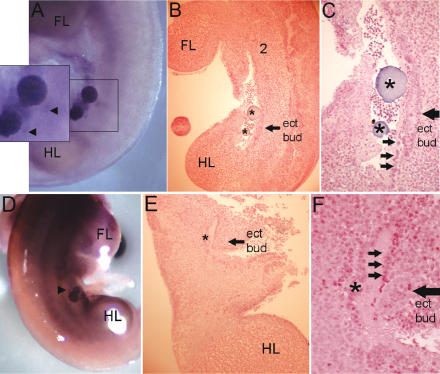Figure 10.
Nrg3 can induce ectopic mammary gland bud formation and Lef1 expression in cultured A/J mouse embryos. Numbers denote the positions of the mammary gland anlage, which have formed during the culture period. (FL) Forelimb bud; (HL) hindlimb bud. (A) Whole-mount in situ hybridization with a Lef1 antisense probe of an A/J embryo implanted (at the 40-somite stage) with two Nrg3-soaked beads and cultured for 24 h. The beads were implanted along the “mammary line” between the sites where buds 3 and 4 will subsequently form. The boxed area highlights the ectopic bud that has formed adjacent to the implanted beads and is indicated by arrowheads in the magnified inset. (B) Sagittal hematoxylin-stained section through the A/J embryo shown in A. The asterisks indicate the locations of the beads. An arrow indicates the location of the ectopic bud. This bud spans the anterior-posterior axis that the two beads span and is either larger than a normal bud or the result of the fusion of two nascent buds. (C) Higher magnification of B. Arrows indicate the dense mesenchyme along the putative mammary line, but in ska (A/J) mice this has a more disorganized appearance. (D) Whole-mount in situ hybridization with a Lef1 antisense probe of a 41-somite-stage A/J embryo implanted at the level of somite 20 with an Nrg3-soaked bead and cultured for 24 h. (E) A sagittal hematoxylin-stained section through the A/J embryo shown in D. The asterisk indicates the location of the bead. An arrow indicates the location of the ectopic bud. (F) Higher magnification of E. Arrows indicate dense “mammary line” mesenchyme.

